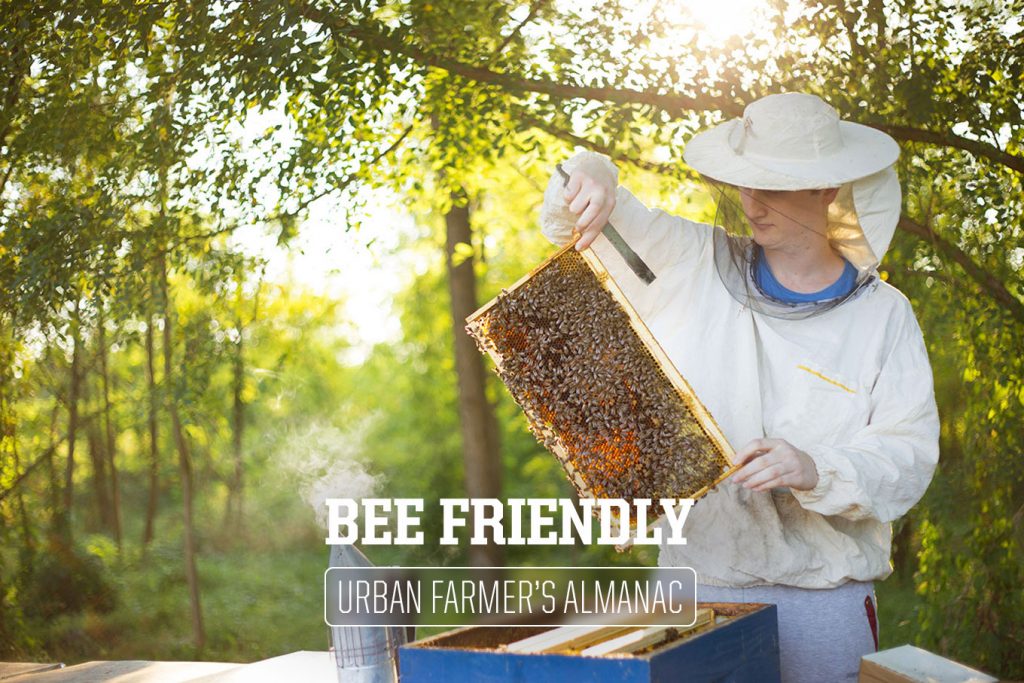Buzworthy
February 12, 2016
Making your garden bee friendly
Honey Bees are great partners when it comes to gardening. Buzzing from flower to flower seeking nectar and pollen, they pollinate those flowers, allowing fruit and vegetable plants to produce the seed and fruit we are seeking. Plus, as a bonus, we get to enjoy the products the Honey Bees produce in the hive, mainly Honey and Beeswax.
Working almost unnoticed alongside those European Imports are many species of native pollinators, not only Bees, but Butterflies and other insects also. The Honey Bees get most of the publicity, but the hardworking and efficient native pollinators actually do far more of the critical work of creating new generations of plants.
Unlike Honey Bees that form a large colony and store up Honey as a winter food supply, most native Bees are solitary, living in individual nests. They pollinate flowers while gathering food to provision the several eggs they will lay. After working for several weeks to provide for the next generation, the bees die and the young spend the rest of the year hatching and pupating in their individual chambers, waiting to emerge the next season to continue the cycle. Depending on the species, their nests may be burrows in the ground, hollow stems of plants, dead tree limbs, mud balls, or even empty snail shells. Our native Bumble Bees do form colonies, but unlike Honey Bees, only a hibernating Queen lives through the winter, so there is no need to store up Honey.
Honey Bees hives can be packed up and moved to new locations as the Bee keeper desires. Not so for the Native bees, most of whom are locally adapted, and only forage a few hundred feet or less from their nest. Therefore it is important that we create or preserve suitable habitat for native pollinators where we can. There are some simple steps we can take that help, even on a small scale.
Leave a few square feet of sunny ground undisturbed year round for the ground nesters. No rototilling or aggressive hoeing, but don’t let it get completely over run with vegetation. Digging in some sand to loosen up the ground plus raising the soil level with an edging of boards or branches can help.
Provide a shallow water source, protected from pets. Use rocks or chunks of clay or wood to provide landing sites. Some mud would be appreciated by many pollinators.
Bundle up hollow or pithy stems from pruning plants like roses, hydrangeas, bamboo, sunflowers or dahlias and put them in a sunny spot protected from wind.
Be judicious about insecticide use, even those ”natural” or Organic ones. Don’t spray open blooms that pollinators will visit. Spray fruit trees after petal drop when bees no longer have reason to visit.
Plant more flowers. Flowers provide food, and food shortages compound all other issues pollinators, including Honey Bees, face today. A wide variety of blooms, from early spring to late fall is important for pollinator health.
EARLY SPRING – Crocus, Maples, Willows, Camellia, Winter Heather, wild Plums, Bleeding Heart.
MAIN SEASON – “Daisy” shaped flowers host many pollinators. Sunflowers are excellent. Clovers of all types are good. Almost all herbs, especially the Mint and Thyme families are loved by bees.
LATE SEASON – Asters, Sedums, Rudbeckia, Cosmos, mid-Summer planted sunflowers. Also shear back herbs in mid-Summer to generate a late season flush of blooms.
Bee Smarts
- Immigrants from Europe brought Honey Bees to North America in the 1600’s. Likely from England to Virginia in 1655.
- There are nearly 4,000 types of native bees in the US. And approx. 20,000 kinds worldwide.
- There are around 45 species of native Bumble Bees in the US.
- Utah is nicknamed the Bee Hive State.
The more we partner with bees and create a thriving refuge for them, the more we both benefit. It’s been a long and mutually beneficial relationship.
Coastal carries bees in starter packages starting with 3lbs of bees (approx. 10,000) with a mated Italian Queen in a separate cage. Check your local Coastal store for availability. We also carry bee frames for your convenience and hold beginning bee keeping classes in multiple store locations starting in February and running through March. Look for other feature articles and ‘How To’ videos featuring bees in the near future.
Coastal also has all your plant and seed varieties to create your bee friendly garden.
Fun Facts
The 29th of February (Leap Year) is also Rare Disease Day, which is fitting, since it’s only recognized every four years.
The largest hailstone ever recorded weighed 2.25 pounds. It landed in Bangladesh in April of 1986, though hopefully, not on anyone’s head.
There are more chickens in the world than any other bird species. About 25 billions cluckers. That’s a lot of chickens crossing the road.
Earthworms are made up of nearly 80% water and breathe through their skin since they have no lungs or respiratory organs.
Unlike all other fish, seahorses swim upright, which makes it easier to saddle them.









